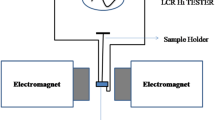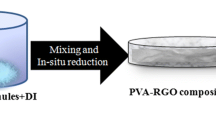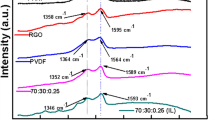Abstract
The polymers poly(vinyl alcohol) (PVA) is used as matrices to synthesize a nanocomposite with reduced graphene oxide (rGO). The structural and optical properties of the rGO and the nanocomposites (rGO–PVA) are studied by XRD, FTIR analysis, FESEM studies, Raman spectroscopy and UV–VIS absorption spectroscopy analysis. Interaction of PVA polymer chains with rGO is confirmed from FTIR study. The bandgap of the PVA and rGO–PVA nanocomposites has been studied from UV–VIS absorption spectrum. The refractive index and optical dielectric constants of PVA, GO, rGO and rGO–PVA nanocomposites have been discussed from optical spectrum analysis. The visual structures of the GO, rGO and rGO–PVA nanocomposites are observed from FESEM study. The electric modulus M*(ɷ) formalism used in the analysis enabled us to distinguish and separate the relaxation processes, dominated by marked conductivity in the ε*(ɷ) representation. In the ceramics studies, the relaxation times are thermally activated and the dipole process has a clearly non-Debye behaviour. The relaxation process is described with the use of the activation energy of approximately EA = 0.12 eV and the characteristic relaxation time, τ0 = 2.07 × 10–7 s. The dielectric property of the nanocomposite (rGO–PVA) is studied in zero magnetic field and in magnetic field (H) up to 1.2 T. From these data, magnetodielectric effects are obtained as the variation of real (ε′) and imaginary (ε″) parts of complex dielectric constant with H at some frequencies. In our study at 100 kHz for the increase of H from zero to 1 T ε′ decreases by 2.5% in rGO–PVA. This fact is indicative of the interaction between rGO filler particles and PVA polymer chains.











Similar content being viewed by others
References
A.K. Geim, K. Novoselov, The rise of graphene. Nature Mater 6, 183–191 (2007)
A.K. Geim, Graphene: status and prospects. Science 324(5934), 1530–1534 (2009)
K. Novoselov, V. Fal′ko, L. Colombo et al., A roadmap for graphene. Nature 490, 192–200 (2012)
Y. Zhu, S. Murali, X. Li, J.W. Suk, J.R. Potts, R.S. Ruof, Graphene and graphene oxide: synthesis, properties, and applications. Adv Mater. 22, 3906–3924 (2010)
M.J. Allen, V.C. Tung, R.B. Kaner, Honeycomb carbon: a review of graphene. Chem. Rev. 110(1), 132–145 (2010)
C.N.R. Rao, A.K. Sood, K.S. Subrahmanyam, A. Govindaraj, Graphene: the new two-dimensional nanomaterial. Agnew Chem. Int. Ed. 48(42), 7752–7777 (2009)
S. Vadukumpully, J. Paul, N. Mahanta, S. Valiyaveettil, Flexible conductive graphene/poly(vinyl chloride) composite thin films with high mechanical strength and thermal stability. Carbon 49(1), 198–205 (2011)
J.O. Iroh, J.P. Chime, D.A. Scola, J.P. Wesson, Electrochemical process for preparing continuous graphite fibre-thermoplastic composites. Polymer 35(6), 1306–1311 (1994)
W. Zheng, S.C. Wong, Electrical conductivity and dielectric properties of PMMA/expanded graphite composites. Compos. Sci. Technol. 63(2), 225–235 (2003)
S Ansari, EP Giannelis (2009) Functionalized graphene sheet—Poly(vinylidene fluoride) conductive nanocomposites. J. Polym. Sci. Part B Polym. Phys. 47(9): 888–897.
X.L. Wang, H. Bai, Z.Y. Yao, A.R. Liu, G.Q. Shi, Electrically conductive and mechanically strong biomimetic chitosan/reduced graphene oxide composite films. J. Mater. Chem. 20(41), 9032–9036 (2010)
S. Bose, T. Kuila, M.E. Uddin, N.H. Kim, A.K.T. Lau, J.H. Lee, In-situ synthesis and characterization of electrically conductive polypyrrole/graphene nanocomposites. Polymer 51(25), 5921–5928 (2010)
S. Stankovich, D. Dikin, G. Dommett et al., Graphene-based composite materials. Nature 442, 282–286 (2006)
H. Kim, A.A. Abdala, C.W. Macosko, Graphene/Polymer Nanocomposites. Macromolecules 43(16), 6515–6530 (2010)
J.R. Potts, D.R. Dreyer, C.W. Bielawski, R.S. Ruoff, Graphene-based polymer nanocomposites. Polymer 52(1), 5–25 (2011)
T. Kuilla, S. Bhadra, D. Yao, N.H. Kim, S. Bose, J.H. Lee, Recent advances in graphene based polymer composites. Prog. Polym. Sci. 35(11), 1350–1375 (2010)
D. Cai, M. Song, Recent advance in functionalized graphene/polymer nanocomposites. J. Mater. Chem. 20(37), 7906–7915 (2010)
R. Verdejo, M.M. Bernal, L.J. Romasanta, M.A. Lopez-Manchado, Graphene filled polymer nanocomposites. J. Mater. Chem. 21(10), 3301–3310 (2011)
X. Huang, X. Qi, F. Boey, H. Zhang, Graphene-based composites. Chem. Soc. Rev. 41(2), 666–686 (2012)
R.J. Young, I.A. Kinloch, L. Gong, K.S. Novoselov, The mechanics of graphene nanocomposites: a review. Comp. Sci Technol. 72(12), 1459–1476 (2012)
Z. Li, R.J. Young, N.R. Wilson, I.A. Kinloch, C. Vallés, Z. Li, Effect of the orientation of graphene-based nanoplatelets upon the Young's modulus of nanocomposites. Comp. Sci Technol. 123, 125–133 (2016)
A.J. Marsden, D.G. Papageorgiou, C. Vallés, A. Liscio, V. Palermo, M.A. Bissett, R.J. Young, I.A. Kinloch, Electrical percolation in graphene–polymer composites. 2DMater. 5(3), 032003 (2018)
K. Hu, D.D. Kulkarni, I. Choi, V.V. Tsukruk, Graphene-polymer nanocomposites for structural and functional applications. Prog. Polym. Sci. 39(11), 1934–1972 (2014)
S. Park, R. Ruoff, Chemical methods for the production of graphenes. Nature Nanotech 4, 217–224 (2009)
D.R. Dreyer, S. Park, C.W. Bielawski, R.S. Ruoff, The chemistry of graphene oxide. Chem. Soc. Rev. 39, 228–240 (2010)
K.P. Loh, Q. Bao, P.K. Ang, J. Yang, The chemistry of graphene. J. Mater. Chem. 20, 2277–2289 (2010)
O.C. Compton, S.T. Nguyen, Graphene oxide, highly reduced graphene oxide, and graphene: versatile building blocks for carbon-based material. Small 6(6), 711–723 (2010)
A. Lerf, H. He, M. Forster, J. Klinowski, Structure of graphite oxide revisited. J. Phys. Chem. B 102(23), 4477–4482 (1998)
H. He, J. Klinowski, M. Forster, A. Lerf, A new structural model for graphite oxide. Chem. Phys Lett. 287(1–2), 53–56 (1998)
S. Mitra, O. Mondal, D.R. Saha, A. Datta, S. Banerjee, D. Chakravorty, Magnetodielectric effect in graphene-PVA nanocomposites. J. Phys. Chem. C 115(29), 14285–14289 (2011)
I. Tantis, G.C. Psarras, D. Tasis, Functionalized graphene–poly(vinyl alcohol) nanocomposites: physical and dielectric properties. eXPRESS Polym Lett 6(4), 283–292 (2012)
J.H. Yang, Y.D. Lee, Highly electrically conductive rGO/PVA composites with a network dispersive nanostructure. J. Mater. Chem. 22(17), 8512–8517 (2012)
W.S. Hummers Jr., R.E. Offeman, Preparation of graphitic oxide. j. Am. Chem. Soc. 80(6), 1339–1339 (1958)
N.I. Kovtyukhova, P.J. Ollivier, B.R. Martin, T.E. Mallouk, S.A. Chizhik, E.V. Buzaneva, A.D. Gorchinskiy, Layer-by-layer assembly of ultrathin composite films from micron-sized graphite oxide sheets and polycations. Chem. Mater. 11(3), 771–778 (1999)
H.J. Salavagione, G. Martínez, M.A. Gómez, Synthesis of poly(vinyl alcohol)/reduced graphite oxide nanocomposites with improved thermal and electrical properties. J. Mater. Chem. 19(28), 5027–5032 (2009)
A. Bahrami, I. Kazeminezhad, Y. Abdi, Pt-Ni/rGO counter electrode: electrocatalytic activity for dye-sensitized solar cell. Superlattices Microstruct. 125, 125–137 (2019)
J. Ma, Y. Li, X. Yin, Y. Xu, J. Yue, J. Bao, T. Zhou, Poly(vinyl alcohol)/graphene oxide nanocomposites prepared by in situ polymerization with enhanced mechanical properties and water vapor barrier properties. RSC Adv. 6, 49448–49458 (2016)
J. Ou, J. Wang, S. Liu, B. Mu, J. Ren, H. Wang, S. Yang, Tribology study of reduced graphene oxide sheets on silicon substrate synthesized via covalent assembly. Langmuir 26(20), 15830–15836 (2010)
S.Z. Moghaddam, S. Sabury, F. Sharif, Dispersion of rGO in polymeric matrices by thermodynamically favorable self-assembly of GO at oil–water interfaces. RSC Adv. 4, 8711–8719 (2014)
Y. Xu, W. Hong, H. Bai, C. Li, G. Shi, Strong and ductile poly(vinyl alcohol)/graphene oxide composite films with a layered structure. Carbon 47(15), 3538–3543 (2009)
C. Bao, Y. Guo, L. Song, Y. Hu, Poly(vinyl alcohol) nanocomposites based on graphene and graphite oxide: a comparative investigation of property and mechanism. J. Mater. Chem. 21(36), 13942–13950 (2011)
S. Gahlot, P.P. Sharma, V. Kulshrestha, P.K. Jha, SGO/SPES-based highly conducting polymer electrolyte membranes for fuel cell application. ACS Appl. Mater. Interfaces 6(8), 5595–5601 (2014)
X. Zhao, M. Gnanaseelan, D. Jehnichen, F. Simon, J. Pionteck, Green and facile synthesis of polyaniline/tannic acid/rGO composites for supercapacitor purpose. J. Mater. Sci. 54, 10809–10824 (2019)
L. Shao, J. Li, Y. Zhang, S. Gong, H. Zhang, Y. Wang, The effect of the reduction extent on the performance of graphene/poly(vinyl alcohol) composites. J. Mater. Chem. A 2(34), 14173–14180 (2014)
M. Cano, U. Khan, T. Sainsbury, A. O'Neill, Z. Wang, I.T. McGovern, W.K. Maser, A.M. Benito, J.N. Coleman, Improving the mechanical properties of graphene oxide based materials by covalent attachment of polymer chains. Carbon 52, 363–371 (2013)
H. Beydaghi, M. Javanbakht, E. Kowsari, Synthesis and characterization of poly(vinyl alcohol)/sulfonated graphene oxide nanocomposite membranes for use in proton exchange membrane fuel cells (PEMFCs). Ind. Eng. Chem. Res. 53(43), 16621–16632 (2014)
H.K. Cheng, N.G. Sahoo, Y.P. Tan, Y. Pan, H. Bao, L. Li, S.H. Chan, J. Zhao, Poly(vinyl alcohol) nanocomposites filled with poly(vinyl alcohol)-grafted graphene oxide. ACS Appl. Mater. Interfaces 4(5), 2387–2394 (2012)
Y. Shi, D. Xiong, J. Li, K. Wang, N. Wang, In situ repair of graphene defects and enhancement of its reinforcement effect in polyvinyl alcohol hydrogels. RSC Adv. 7, 1045–1055 (2017)
V.C. Tung, M.J. Allen, Y. Yang, R.B. Kaner, High-throughput solution processing of large-scale graphene. Nat. Nanotechnol. 4, 25–29 (2009)
H. Chen, R. Li, X. Xu, P. Zhao, D.S.H. Wong, X. Chen, S. Chen, X. Yan, Citrate-based fluorophores in polymeric matrix by easy and green in situ synthesis for full-band UV shielding amd emissive transparent disply. J. Mater. Sci. 54, 1236–1247 (2019)
Q. Lai, S. Zhu, X. Luo, M. Zou, S. Huang, Ultraviolet-visible spectroscopy of graphene oxides. AIP Adv. 2, 032146-1–032146-5 (2012)
C.P.P. Wong, C.W. Lai, K.M. Lee, S.B.A. Hamid, Advanced chemical reduction of reduced graphene oxide and its photocatalytic activity in degrading reactive black 5. Materials 8(10), 7118–7128 (2015)
R.M. Abdullah, S.B. Aziz, S.M. Mamand, A.Q. Hassan, S.A. Hussein, M.F.Z. Kadir, Reducing the crystallite size of spherulites in PEO-based polymer nanocomposites mediated by carbon nanodots and Ag nanoparticles. Nanomaterials 9(6), 874 (2019)
S.B. Aziz, M.A. Rasheed, A.M. Hussein, H.M. Ahmed, Fabrication of polymer blend composites based on [PVA-PVP](1−x):(Ag2S)x (0.01 ≤ x ≤ 0.03) with small optical band gaps: Structural and optical properties. Mater. Sci. Semiconductor Process 71: 197–203 (2017).
S. B. Aziz, Aso Q. Hassan, Sewara J. Mohammed, Wrya O. Karim, M. F. Z. Kadir, H. A. Tajuddin and N. N. M. Y. Chan, Structural and optical characteristics of PVA:C-Dotcomposites: tuning the absorption of ultra violet (UV) region. Nanomaterials 9, 216 (2019).
A.K. Bhunia, T. Kamilya, S. Saha, Temperature dependent and kinetic study of the adsorption of bovine serum albumin to ZnO nanoparticle surfaces. Chem Select 1(11), 2872–2882 (2016)
S.B. Aziz, Modifying Poly(Vinyl Alcohol) (PVA) from insulator to small-bandgap polymer: a novel approach for organic solar cells and optoelectronic devices. J Electron Mater 45, 736–745 (2016)
S.B. Aziz, M.A. Rasheed, H.M. Ahmed, Synthesis of polymer nanocomposites based on [Methyl Cellulose](1−x):(CuS)x (0.02 M ≤ x ≤ 0.08 M) with desired optical band gaps. Polymers, 9, 194. (2017).
M.A. Brza, S.B. Aziz, H. Anuar, M.H.F. Al Hazza, From green remediation to polymer hybridfabrication with improved optical band gaps. Int. J. Mol. Sci. 20, 3910 (2019)
S.B. Aziz, H.M. Ahmed, A.M. Hussein, A.B. Fathulla, R.M. Wsw, R.T. Hussein, Tuning the absorption of ultraviolet spectra and optical parameters of aluminum doped PVA based solid polymer composites. J Mater Sci. 26(10), 8022–8028 (2015)
S.B. Aziz, R.T. Abdulwahid, H.A. Rsaul, H.M. Ahmed, In situ synthesis of CuS nanoparticle with a distinguishable SPR peak in NIR region. J Mater Sci. 27(5), 4163–4171 (2016)
S.B. Aziz, Morphological and optical characteristics of Chitosan(1–x):Cuox (4 ≤ x ≤ 12) based polymer nano-composites: optical dielectric loss as an alternative method for Tauc’s model. Nanomaterials 7, 444 (2017)
N.G. McCrum, B.E. Read, G. Williams, Anelastic and dielectric effects in polymeric solids (Wiley, New York, 1967)
H. Wagner, R. Richert, Thermally stimulated modulus relaxation in polymers: method and interpretation. Polymer 38(23), 5801–5806 (1997)
C. Leon, M.L. Lucia, J. Santamaria, Correlated ion hopping in single-crystal yttria-stabilized zirconia. Phys. Rev. B 55(2), 882 (1998)
R. Richert, H. Wagner, The dielectric modulus: relaxation versus retardation. Solid State Ion. 105(1–4), 167–173 (1998)
P.B. Macedo, C.T. Moynihan, R. Bose, The role of ionic diffusion in polarisation in vitreous ionic conductORS. Phys. Chem. Glasses 13(6), 171–179 (1972)
J. Liu, C.G. Duan, W.G. Yin, W.N. Mei, R.W. Smith, J.R. Hardy, Dielectric permittivity and electric modulus in Bi2Ti4O11. J. Chem. Phys. 119(5), 2812 (2003)
G. Kandhol, H. Wadhwa, S. Chand, S. Mahendia, S. Kumar, Study of dielectric relaxation behaviour of composites of Poly(vinyl alchohol)(PVA) and Reduced grapheme oxide(RGO). Vacuum 160(02), 384–393 (2019)
G. Williams, D.C. Watts, Non-symmetrical dielectric relaxation behaviour arising from a simple empirical decay function. Trans. Faraday Soc. 66, 80–85 (1970)
V. Mydhili, S. Manivannan, Electrical and dielectric behaviour in poly(vinyl alcohol)/poly(3,4-ethylenedioxythiophene):poly(styrenesulfonate) blend for energy storage applications. Polym. Bull. 76, 4735–4752 (2019)
M.M. Parish, P.B. Littlewood, Magnetocapacitance in nonmagnetic composite media. Phys. Rev. Lett. 101(16), 166602 (2008)
G. Catalan, Magnetocapacitance without magnetoelectric coupling. Appl. Phys. Lett. 88(10), 102902 (2006)
X. Xia, J. Hao, Y. Wang, Z. Zhong, G.J. Weng, Theory of electrical conductivity and dielectric permittivity of highly aligned graphene-based nanocomposites. J. Phys. 29, 205702 (2017)
X. Xia, Y. Wang, Z. Zhong, G.J. Weng, A theory of electrical conductivity, dielectric constant, and electromagnetic interference shielding for lightweight graphene composite foams. J. Appl. Phys. 120, 085102 (2016)
J.W. Shang, Y.H. Zhang, L. Yu, B. Shen, F. Lv, P.K. Chu, Fabrication and dielectric propertiesof oriented polyvinylidene fluoride nanocomposites incorporated with graphene nanosheets. Mater. Chem. Phys. 134(2–3), 867–874 (2012)
E.J.G. Santos, E. Kaxiras, Electric-field dependence of the effective dielectric constant in graphene. Nano Lett. 13(3), 898–902 (2013)
S. Sarkar, A. Mondal, K. Dey, R. Ray, Defect driven tailoring of colossal dielectricity of reduced graphene oxide. Mat. Res. Bull. 74, 465–471 (2016)
X. Hong, W. Yu, D.D.L. Chung, Electric permittivity of reduced graphite oxide. Carbon 111, 182–190 (2017)
Acknowledgements
Authors are thankful to the Department of Physics, Department of Electronics of Midnapore College (Autonomous) for various instruments facilities. We thank the CRF, IIT Kharagpur, India for providing Raman, FTIR and FESEM measurement facilities. We thank UGC, India for awarding a MRP grant Vide UGC letter No. F. PSW–224/15-16(ERO) dt.16 Nov.16 to Dr. S.S. Pradhan, Assistant Professor, Midnapore College (Autonomous) Midnapore 721101, India for pursuing this research work. Authors are also thanksful to the Department of Physics, Government General Degree College at Gopiballavpur-II.
Author information
Authors and Affiliations
Corresponding author
Additional information
Publisher's Note
Springer Nature remains neutral with regard to jurisdictional claims in published maps and institutional affiliations.
Rights and permissions
About this article
Cite this article
Ghosh, T.N., Bhunia, A.K., Pradhan, S.S. et al. Electric modulus approach to the analysis of electric relaxation and magnetodielectric effect in reduced graphene oxide–poly(vinyl alcohol) nanocomposite. J Mater Sci: Mater Electron 31, 15919–15930 (2020). https://doi.org/10.1007/s10854-020-04153-5
Received:
Accepted:
Published:
Issue Date:
DOI: https://doi.org/10.1007/s10854-020-04153-5




